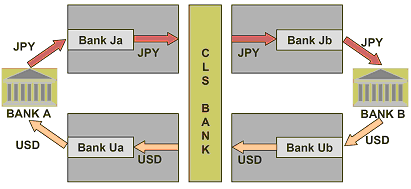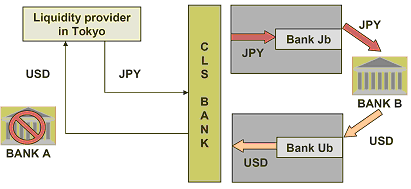How CLS works - a simplified example
(Extract from page 57 of BIS Quarterly Review, September 2008)
CLS Bank (CLS) is a limited purpose bank for settling FX, based in New York with its main operations in London. It is owned by 69 financial institutions which are significant players in the FX market. It currently settles trades in 17 currencies, three in North America (Canadian dollar, Mexican peso and US dollar), two in Africa and the Middle East (Israeli shekel and South African rand), six in Europe (Danish krone, euro, Norwegian krone, Swedish krona, Swiss franc and pound sterling) and six in the Asia-Pacific region (Australian dollar, Hong Kong dollar, Japanese yen, Korean won, New Zealand dollar and Singapore dollar).
The simple example below, which uses the same yen/US dollar trade as in the previous box, is designed to show the essence of the CLS mechanism in the case of a single trade. In reality, CLS settles a large number of trades between multiple counterparties and has complex risk control mechanisms to enable it to do this safely.
CLS removes principal risk by using PVP - you get paid only if you pay. On settlement day, each counterparty to the trade pays to CLS the currency it is selling - eg by using a correspondent bank, as with the example in the previous box. However, unlike the previous example, CLS pays out the bought currency only if the sold currency is received. In effect, CLS acts as a trusted third party in the settlement process. (However, note that CLS is not a central counterparty - in the example shown, the trade remains between Banks A and B.)
CLS could have been designed so that, if one of the counterparties fails, CLS simply returns the principal amount to the surviving counterparty - in the example, it could return the US dollars to Bank B. However, in practice CLS has committed standby lines of credit with major banks in each of the currencies it settles. In this case, Bank B was buying yen, so CLS will swap the US dollars for yen with its yen liquidity provider in Tokyo, and then give the yen to Bank B. In this way, CLS not only removes principal risk but also reduces liquidity risk. However, the standby liquidity facilities cannot completely remove liquidity risk. The main underlying reason for this is that the liquidity facilities are finite while there is no limit on the total value of the trades that you can attempt to settle via CLS.


